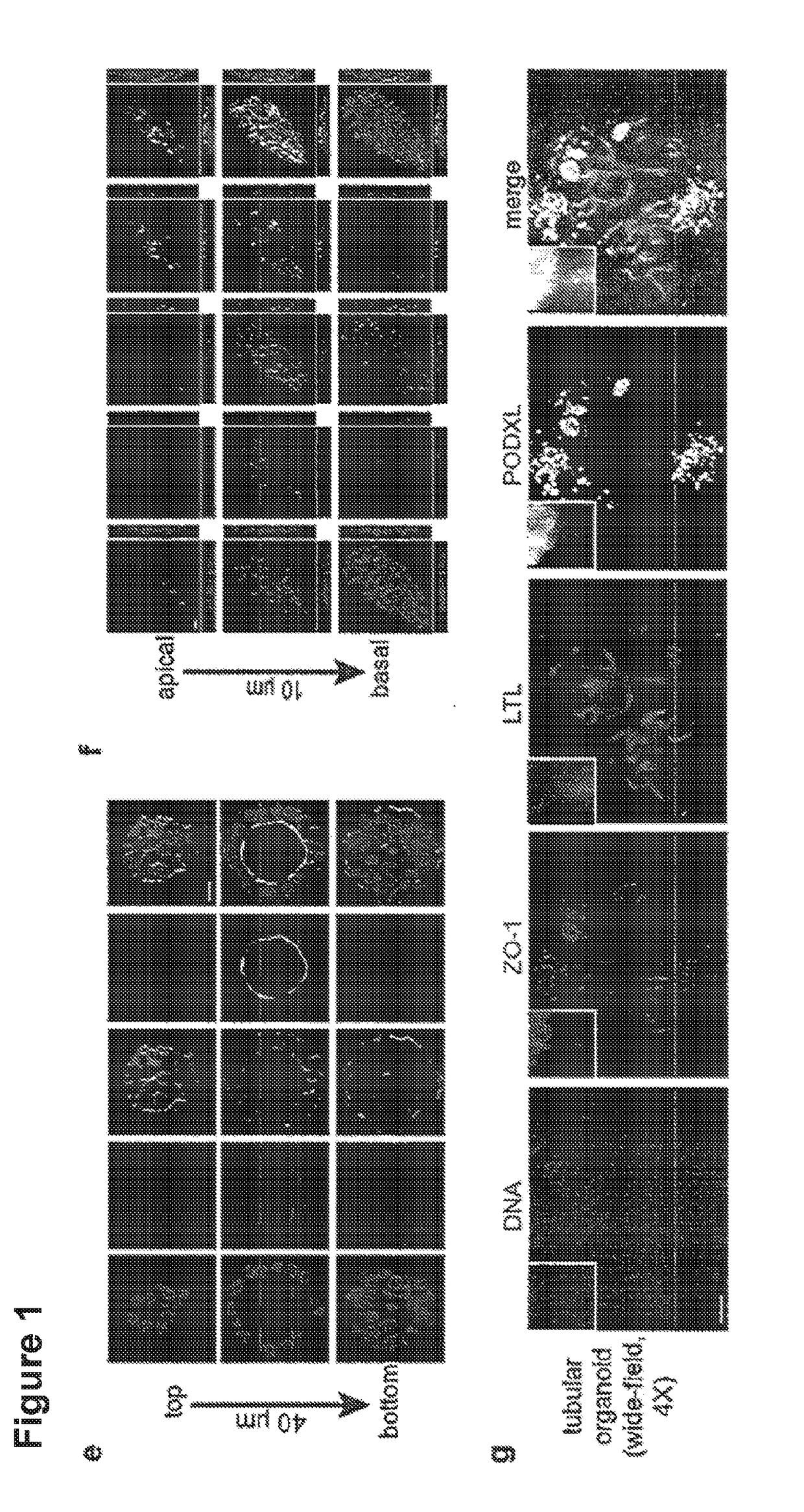Three-dimensional differentiation of epiblast spheroids to kidney organoids models stage-specific epithelial physiology, morphogenesis, and disease
a three-dimensional differentiation and kidney technology, applied in the field of three-dimensional differentiation of epiblast spheroids to kidney organoids models stage-specific epithelial physiology, morphogenesis, and disease, can solve the problems of difficult control comparison of different epithelia of the same genetic background, lineage restriction of conventional epithelial cell lines, and lack of genetic diversity
- Summary
- Abstract
- Description
- Claims
- Application Information
AI Technical Summary
Benefits of technology
Problems solved by technology
Method used
Image
Examples
example 1
3D Culture
[0065]Cell lines included H9 (WA09), BJ, HDFn, hLR5, hfib2-iPS4, and hfib2-iPS5 (human) and J1, R1, and v6 (mouse). Cells were maintained feeder-free on 3% Reduced Growth Factor GeiTrex (Life Technologies) for at least one passage in media (mTeSR1 for hPSCs; N2 / 827 supplement+2i in for mESCs; hESC conditioned media (CM)+leukemia inhibitory factor (LIF)+dox for hLR5 iPSCs) and dissociated with Accutase or TrypLE. LD-iPSCs were derived from native hLR5 iPSCs by withdrawing LIF and doxycycline and substituting with FGF2. For thin gel sandwich colonies, cells were plated at 60,000 (primed) or 30,000 (native) cells / well of a 24-well plate or 4-well chamber slide pre-coated with GeiTrex in media supplemented with 10 μM Rho-kinase inhibitor Y27632 (StemGent). The following day the media was replaced with 500 μL 1.5% GeiTrex in mTeSR1. Media was changed after 24 hours. For thick gel cultures, 20,000 (epiblast-stage) or 6,000 (narve) cells / well of a 96-well plate were resuspended i...
example 2
Tubular Organoid Differentiation
[0066]60,000-120,000 H9 hPSCs were plated, sufficient to produce scattered, isolated spheroid colonies. 48 hours after sandwiching, hPSC spheroids were treated with 12 μM CHIR for 36 hours, then changed to RB (Advanced RPMI+Glutamax+B27 Supplement) and replaced every three days thereafter. Alternatively, spheroids were treated with 12 μM CHIR in RB minus insulin (RBNI) for 24 hours, RBNI for 48 hours, 5 μM IWP2 for 48 hours, RBNI for 48 hours, and RB every three days thereafter, as described for 2D cardiomyocyte differentiation. For 2D kidney differentiation, cells were plated overnight and then treated with 8 μM CHIR in APEL media (StemCell Technologies) for 48-72 hours, 30 ng / ml FGF2+1 μg / ml heparin in APEL media for 96 hours, and subsequently cultured in APEL media for 10-15 days. For stochastic differentiation, hPSCs in 2D or 3D cultures were treated with 10% fetal bovine serum (FBS) in DMEM+P / S and observed for 19 days. Immunofluorescence and Ele...
example 3
[0068]Permeability Assays
[0069]To test permeability, media was supplemented with 20 mM HEPES plus Lucifer Yellow carbohydrazide potassium salt (Invitrogen, 38 μM) and Rhodamine-8 isothiocyanate dextran (Sigma, 0.5 μM), and imaged by confocal microscopy. For microinjection, 5 μM rhodamine-conjugated dextran solution in mTeSR1 was diluted 1:1 with Phenol Red Solution (0.5%, Sigma) for visualization. 2 nl was microinjected via a pulled glass capillary microneedle on a Nanoject-2 micromanipulator, and monitored in real-time by wide-field epifluorescence. For TEER, 50,000 hPSCs were plated on 24-well transwell plates (Corning) pre-coated with dilute Matrigel. The media was gently exchanged for 10 days until cells were completely confluent. TEER was measured using an EVOM 2 device (World Precision Instruments).
PUM
| Property | Measurement | Unit |
|---|---|---|
| time | aaaaa | aaaaa |
| Time | aaaaa | aaaaa |
| Brightfield time | aaaaa | aaaaa |
Abstract
Description
Claims
Application Information
 Login to View More
Login to View More - R&D
- Intellectual Property
- Life Sciences
- Materials
- Tech Scout
- Unparalleled Data Quality
- Higher Quality Content
- 60% Fewer Hallucinations
Browse by: Latest US Patents, China's latest patents, Technical Efficacy Thesaurus, Application Domain, Technology Topic, Popular Technical Reports.
© 2025 PatSnap. All rights reserved.Legal|Privacy policy|Modern Slavery Act Transparency Statement|Sitemap|About US| Contact US: help@patsnap.com



